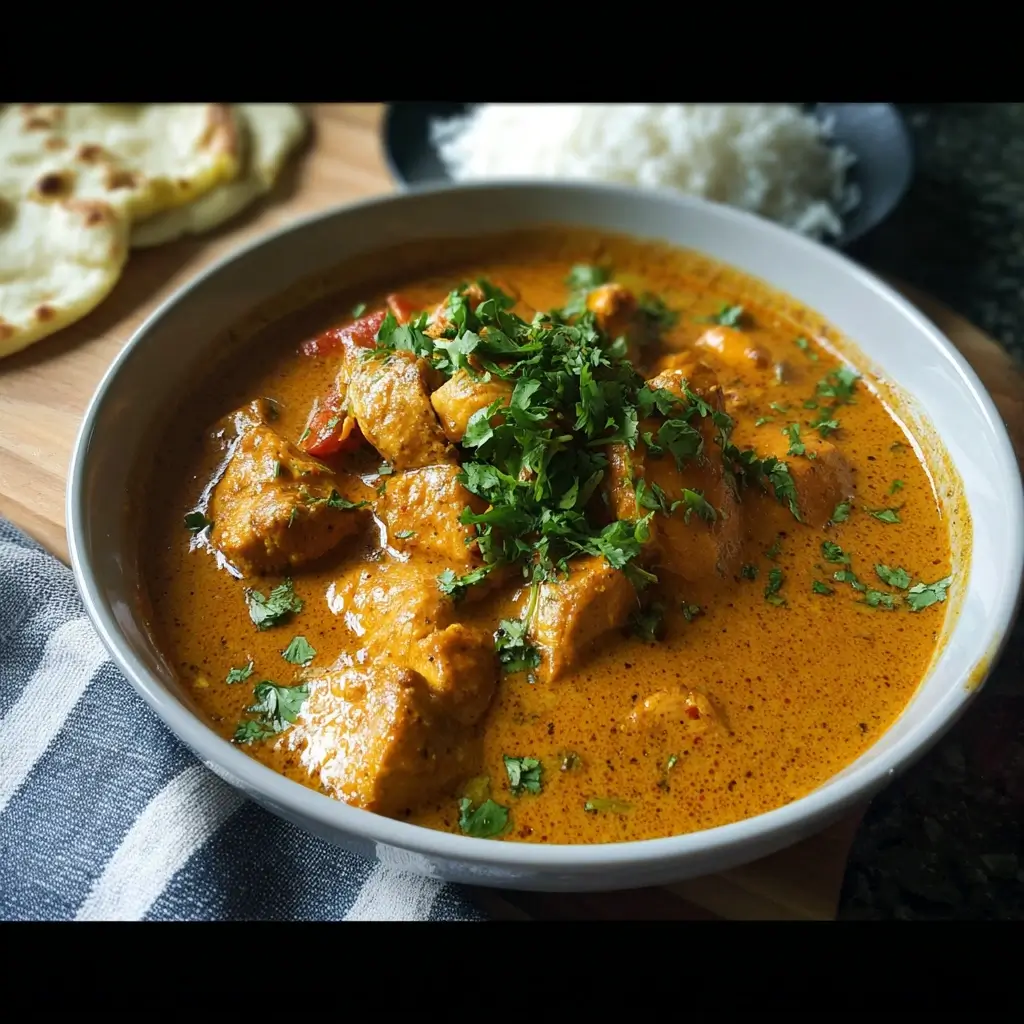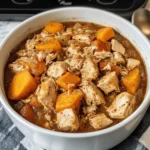Of all the dishes in my culinary repertoire, the one that feels most like a warm, comforting hug is this very chicken curry. I still remember the first time I attempted it, years ago, nervous about getting the balance of spices just right. The aroma that began to fill my kitchen—a heady mix of ginger, garlic, and toasted cumin—was the first sign that I was on the right track. When my family sat down for dinner, the initial silence was quickly replaced by murmurs of appreciation. My husband, usually a man of few words when it comes to food, looked up and said, “This is incredible. Don’t ever lose this recipe.” Since that day, this simple yet profoundly flavorful chicken curry has become our go-to for chilly evenings, celebratory weeknight dinners, and for when we just need a bowl of something that soothes the soul. It’s a recipe that has been tweaked and perfected over time, resulting in a sauce that is rich and creamy without being heavy, and chicken so tender it practically melts in your mouth. It’s more than just a meal; it’s a memory-maker.
The Ultimate Comforting Chicken Curry Recipe
This recipe is designed for maximum flavor with accessible ingredients and straightforward steps. It strikes the perfect balance between creamy, savory, and aromatic, making it a guaranteed crowd-pleaser.
Yields: 6 servings
Calories per serving: Approximately 485 kcal (This can vary based on the cut of chicken and specific ingredients used)
Preparation Time: 15 minutes
Cook Time: 35-40 minutes
Total Time: 50-55 minutes
Ingredients You’ll Need
Gathering your ingredients, or mise en place, is the first step to a stress-free cooking experience. Here’s everything you need to create this spectacular curry.
For the Chicken and Marinade (Optional but Recommended):
- 1.5 lbs (about 700g) boneless, skinless chicken thighs, cut into 1-inch cubes
- 1/2 teaspoon salt
- 1/4 teaspoon black pepper
- 1/2 teaspoon turmeric powder
For the Curry Sauce:
- 2 tablespoons coconut oil (or vegetable oil, ghee)
- 1 large yellow onion (about 1.5 cups), finely chopped
- 3 cloves garlic, minced
- 1-inch piece of fresh ginger, grated
- 1 jalapeño or serrano chili, finely chopped (optional, for heat)
- 2 tablespoons curry powder (a good quality, medium-heat one)
- 1 teaspoon ground cumin
- 1 teaspoon ground coriander
- 1/2 teaspoon paprika (or smoked paprika for a smokier flavor)
- 1 (15-ounce / 425g) can crushed or diced tomatoes, undrained
- 1 (13.5-ounce / 400ml) can full-fat coconut milk (This is crucial for creaminess)
- 1 tablespoon tomato paste
- 1 cup chicken broth (low-sodium)
- 1 teaspoon garam masala
- 1 tablespoon fresh lime juice
- Salt and black pepper to taste
For Garnish:
- 1/2 cup fresh cilantro, chopped
- Extra lime wedges for serving
Step-by-Step Instructions to a Perfect Curry
Follow these detailed instructions carefully. We’ll break down each phase of the cooking process to ensure you achieve a curry with deep, well-developed flavor.
Step 1: Prepare the Chicken
If you have a few extra minutes, a quick marinade makes a world of difference. In a medium bowl, toss the cubed chicken thighs with 1/2 teaspoon of salt, 1/4 teaspoon of black pepper, and 1/2 teaspoon of turmeric powder. The turmeric not only adds a beautiful golden hue but also imparts a subtle, earthy flavor directly into the meat. Set it aside while you prepare the other ingredients. If you’re short on time, you can skip this marinating step.
Step 2: Sauté the Aromatics (The Flavor Base)
Heat the 2 tablespoons of coconut oil in a large Dutch oven or a heavy-bottomed pot over medium heat. Once the oil is shimmering, add the finely chopped onion. Sauté for 5-7 minutes, stirring occasionally, until the onions are soft, translucent, and just beginning to turn golden at the edges. Don’t rush this step; properly softened onions release sugars that form the sweet, savory foundation of your curry sauce.
Add the minced garlic, grated ginger, and optional chopped chili. Cook for another 1-2 minutes, stirring constantly until they become intensely fragrant. Be careful not to let the garlic burn, as it will turn bitter.
Step 3: Bloom the Spices
This is a critical step for unlocking the full potential of your dried spices. Add the 2 tablespoons of curry powder, 1 teaspoon of cumin, 1 teaspoon of coriander, and 1/2 teaspoon of paprika directly into the pot with the aromatics. Stir continuously for about 60 seconds. You’ll notice the spices become darker and release a rich, toasted aroma. This process, known as “blooming,” wakes up the essential oils in the spices, resulting in a much deeper and more complex flavor profile than if you were to simply add them to the liquid later.
Step 4: Sear the Chicken
Increase the heat to medium-high. Add the chicken pieces to the pot in a single layer if possible. Cook for 3-4 minutes, stirring occasionally, until the chicken is lightly browned on all sides. You are not trying to cook it through at this stage; the goal is to get a nice sear on the outside, which locks in the juices and adds another layer of flavor (thanks to the Maillard reaction). The chicken will be coated in the beautiful spice mixture.
Step 5: Build the Rich and Creamy Sauce
Pour in the can of crushed tomatoes, using a wooden spoon to scrape up any browned bits (the “fond”) from the bottom of the pot. Those bits are concentrated flavor! Stir in the tomato paste until it is well combined.
Next, pour in the full-fat coconut milk and the chicken broth. Stir everything together until the sauce is smooth and uniform in color. Bring the mixture to a gentle simmer.
Step 6: Simmer to Perfection
Once the curry is simmering, reduce the heat to low, cover the pot, and let it cook for 20-25 minutes. This slow simmer is where the magic happens. The chicken will finish cooking and become incredibly tender, and the flavors of all the individual components will meld together into a harmonious, delicious sauce. The sauce will also thicken slightly during this time.
Step 7: The Finishing Touches
After the simmering time is up, uncover the pot. The chicken should be cooked through and tender. Stir in the 1 teaspoon of garam masala and the 1 tablespoon of fresh lime juice. Garam masala is a finishing spice blend, and adding it at the end preserves its delicate, aromatic compounds. The lime juice brightens up all the rich, deep flavors and provides a necessary touch of acidity to balance the creaminess of the coconut milk.
Give the curry a final taste. Adjust with more salt and pepper as needed. If you desire more heat, a pinch of cayenne pepper can be added here.
Finally, stir in most of the chopped fresh cilantro, reserving a little for garnish. Let the curry sit for 5-10 minutes off the heat before serving; this allows the flavors to settle and deepen even further.
Nutrition Facts
- Servings: 6
- Calories per serving: Approximately 485 kcal
Please note that these nutritional values are an estimate and can vary based on factors like the specific brand of coconut milk, the fat content of the chicken, and any additional ingredients or serving accompaniments you choose.
How to Serve Your Masterpiece Chicken Curry
Serving curry is an art in itself. The right accompaniments can elevate the dish from great to unforgettable. Here are some classic and creative ways to serve your creation:
- With Steamed Rice:
- Basmati Rice: The classic choice. Its long, fragrant grains are perfect for soaking up the delicious sauce.
- Jasmine Rice: A slightly stickier and fragrant alternative.
- Brown Rice: For a healthier, whole-grain option with a nutty flavor.
- With Breads:
- Naan Bread: A must-have for many. Warm, fluffy naan (plain, butter, or garlic) is perfect for scooping up every last bit of curry.
- Roti or Chapati: A simpler, unleavened whole-wheat flatbread that is also an excellent vehicle for the sauce.
- Add Toppings and Sides for Texture and Flavor:
- A Dollop of Yogurt or Raita: Plain yogurt or a simple cucumber raita (yogurt mixed with grated cucumber, mint, and a pinch of cumin) provides a cool, creamy contrast to the warm spices of the curry.
- Fresh Garnishes: A sprinkle of extra fresh cilantro, some thinly sliced red onion, or even some fresh mint leaves can add a burst of freshness.
- A Squeeze of Lime: Always serve with extra lime wedges on the side. A final squeeze just before eating can reawaken all the flavors.
- Mango Chutney: A spoonful of sweet and tangy mango chutney on the side adds a wonderful counterpoint to the savory curry.
- Toasted Nuts or Seeds: For a bit of crunch, try a sprinkle of toasted cashews, slivered almonds, or pumpkin seeds.
Additional Tips for Curry Perfection
- Don’t Substitute Full-Fat Coconut Milk: While it might be tempting to use “light” or low-fat coconut milk to save calories, it’s the fat content that creates that luxuriously rich and creamy sauce. Light coconut milk can result in a thinner, less satisfying curry and may even curdle when simmered. For this recipe, stick with the full-fat version for the best results.
- Make it Ahead for Deeper Flavor: Like many stews and braises, chicken curry tastes even better the next day. The flavors continue to meld and deepen as it sits in the refrigerator. If you have the time, make it a day in advance, let it cool completely, and store it in the fridge. Reheat gently on the stovetop before serving.
- Customize Your Vegetables: This recipe is a fantastic base for adding vegetables. You can make it a more complete one-pot meal by adding them in. Heartier vegetables like diced potatoes or carrots should be added with the tomatoes and broth to give them enough time to cook. Quicker-cooking vegetables like spinach, peas, or bell peppers can be stirred in during the last 5-10 minutes of simmering.
- Control the Spice Level: The heat in this recipe comes primarily from the optional chili and the curry powder itself. To make it milder, omit the chili and use a mild curry powder. To make it spicier, add more chili (or leave the seeds in), use a hot curry powder, or add a pinch of cayenne pepper or red pepper flakes along with the other spices.
- Achieve the Perfect Sauce Consistency: If your curry sauce seems too thin for your liking after simmering, you can thicken it easily. Simply remove the lid and let it simmer for an additional 5-10 minutes, which will allow some of the excess liquid to evaporate. Conversely, if it becomes too thick, you can thin it out by stirring in a splash of chicken broth or water until it reaches your desired consistency.
Frequently Asked Questions (FAQ)
Q1: Can I use chicken breast instead of chicken thighs?
A: Absolutely! You can use chicken breast if you prefer. However, chicken thighs contain more fat, which makes them more flavorful and forgiving; they tend to stay juicier during the simmering process. If using chicken breast, be careful not to overcook it. You might want to reduce the simmering time slightly (check for doneness after 15 minutes) to ensure it remains tender and doesn’t become dry or stringy.
Q2: My curry tastes a bit flat. What did I do wrong?
A: A “flat” taste in curry usually means it’s missing one of the key flavor pillars: salt, acid, or sweetness. Before adding anything else, first, make sure it’s salted properly. A little more salt can often make all the other flavors pop. If it’s still missing something, the next best thing to add is a squeeze of lime juice for acidity, which brightens everything up. The final touch could be a tiny pinch of sugar (less than 1/4 teaspoon) to balance the acidity of the tomatoes, but usually, the lime and salt are all that’s needed.
Q3: How do I store and reheat leftover chicken curry?
A: Leftover chicken curry stores beautifully. Allow it to cool completely to room temperature, then transfer it to an airtight container. It will keep in the refrigerator for up to 4 days. To reheat, you can either warm it in a saucepan over medium-low heat on the stovetop or microwave it in a covered, microwave-safe dish until hot. The stovetop method is generally preferred for the best texture. The curry may thicken in the fridge; you can add a splash of water or broth when reheating to loosen it up.
Q4: Can I freeze this chicken curry?
A: Yes, this curry freezes very well, making it a perfect meal-prep dish. Let the curry cool completely, then portion it into freezer-safe containers or bags. It can be frozen for up to 3 months. To serve, thaw it overnight in the refrigerator and then reheat gently on the stovetop. Note that sometimes the texture of coconut milk can change slightly upon freezing and thawing, but it should still be delicious once reheated and stirred well.
Q5: What makes a curry “authentic”? Is this recipe authentic?
A: “Authentic” is a complex term when it comes to curry, as there are thousands of variations across India and Southeast Asia, with every region and even every family having its own unique style. This recipe is a Western-style “curry” that is heavily inspired by Indian flavors and techniques, such as blooming the spices and using a base of onion, ginger, and garlic. It’s designed to be accessible, using common ingredients like a pre-blended curry powder, while still delivering a deep, satisfying flavor that honors its culinary roots. It’s an authentic expression of a delicious, homemade meal.

Chicken Curry Recipe
Ingredients
For the Chicken and Marinade (Optional but Recommended):
- 1.5 lbs (about 700g) boneless, skinless chicken thighs, cut into 1-inch cubes
- 1/2 teaspoon salt
- 1/4 teaspoon black pepper
- 1/2 teaspoon turmeric powder
For the Curry Sauce:
- 2 tablespoons coconut oil (or vegetable oil, ghee)
- 1 large yellow onion (about 1.5 cups), finely chopped
- 3 cloves garlic, minced
- 1-inch piece of fresh ginger, grated
- 1 jalapeño or serrano chili, finely chopped (optional, for heat)
- 2 tablespoons curry powder (a good quality, medium-heat one)
- 1 teaspoon ground cumin
- 1 teaspoon ground coriander
- 1/2 teaspoon paprika (or smoked paprika for a smokier flavor)
- 1 (15-ounce / 425g) can crushed or diced tomatoes, undrained
- 1 (13.5-ounce / 400ml) can full-fat coconut milk (This is crucial for creaminess)
- 1 tablespoon tomato paste
- 1 cup chicken broth (low-sodium)
- 1 teaspoon garam masala
- 1 tablespoon fresh lime juice
- Salt and black pepper to taste
For Garnish:
- 1/2 cup fresh cilantro, chopped
- Extra lime wedges for serving
Instructions
If you have a few extra minutes, a quick marinade makes a world of difference. In a medium bowl, toss the cubed chicken thighs with 1/2 teaspoon of salt, 1/4 teaspoon of black pepper, and 1/2 teaspoon of turmeric powder. The turmeric not only adds a beautiful golden hue but also imparts a subtle, earthy flavor directly into the meat. Set it aside while you prepare the other ingredients. If you’re short on time, you can skip this marinating step.
Heat the 2 tablespoons of coconut oil in a large Dutch oven or a heavy-bottomed pot over medium heat. Once the oil is shimmering, add the finely chopped onion. Sauté for 5-7 minutes, stirring occasionally, until the onions are soft, translucent, and just beginning to turn golden at the edges. Don’t rush this step; properly softened onions release sugars that form the sweet, savory foundation of your curry sauce.
Add the minced garlic, grated ginger, and optional chopped chili. Cook for another 1-2 minutes, stirring constantly until they become intensely fragrant. Be careful not to let the garlic burn, as it will turn bitter.
This is a critical step for unlocking the full potential of your dried spices. Add the 2 tablespoons of curry powder, 1 teaspoon of cumin, 1 teaspoon of coriander, and 1/2 teaspoon of paprika directly into the pot with the aromatics. Stir continuously for about 60 seconds. You’ll notice the spices become darker and release a rich, toasted aroma. This process, known as “blooming,” wakes up the essential oils in the spices, resulting in a much deeper and more complex flavor profile than if you were to simply add them to the liquid later.
Increase the heat to medium-high. Add the chicken pieces to the pot in a single layer if possible. Cook for 3-4 minutes, stirring occasionally, until the chicken is lightly browned on all sides. You are not trying to cook it through at this stage; the goal is to get a nice sear on the outside, which locks in the juices and adds another layer of flavor (thanks to the Maillard reaction). The chicken will be coated in the beautiful spice mixture.
Pour in the can of crushed tomatoes, using a wooden spoon to scrape up any browned bits (the “fond”) from the bottom of the pot. Those bits are concentrated flavor! Stir in the tomato paste until it is well combined.
Next, pour in the full-fat coconut milk and the chicken broth. Stir everything together until the sauce is smooth and uniform in color. Bring the mixture to a gentle simmer.
Once the curry is simmering, reduce the heat to low, cover the pot, and let it cook for 20-25 minutes. This slow simmer is where the magic happens. The chicken will finish cooking and become incredibly tender, and the flavors of all the individual components will meld together into a harmonious, delicious sauce. The sauce will also thicken slightly during this time.
After the simmering time is up, uncover the pot. The chicken should be cooked through and tender. Stir in the 1 teaspoon of garam masala and the 1 tablespoon of fresh lime juice. Garam masala is a finishing spice blend, and adding it at the end preserves its delicate, aromatic compounds. The lime juice brightens up all the rich, deep flavors and provides a necessary touch of acidity to balance the creaminess of the coconut milk.
Give the curry a final taste. Adjust with more salt and pepper as needed. If you desire more heat, a pinch of cayenne pepper can be added here.
Finally, stir in most of the chopped fresh cilantro, reserving a little for garnish. Let the curry sit for 5-10 minutes off the heat before serving; this allows the flavors to settle and deepen even further.
Nutrition
- Serving Size: One Normal Portion
- Calories: 485





